Showing 221–230 of 239 results
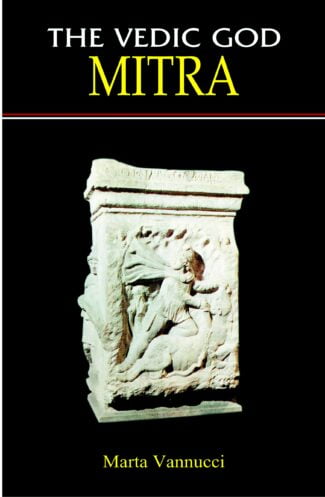
The book talks about the origin, personality and evolution of the Vedic God Mitra, and refers to the Rigveda and emergence of new gods as facets of the original Mitra-Mithra with time. It also delves into religious and cultural aspects of life associated with Him.
The Vedic God Mitra was highly revered and invoked for proper fulfilment of civil and religious acts and duties. Mentioned 175 times in the Rigveda alone, He has been described as one of the most wonderful, glorious and mighty of the Vedic gods.
This work presents a synthetic study of the evolution of the personality of Mitra, a most significant representative of the early stages of the ancient Indo-Aryan and Indo-Iranian cultures. Beginning with a discussion on the name and personality of the Vedic God, Mitra, the work deals with the evolution of the god by referring to the Rigveda and emergence of new gods as facets of the original Mitra-Mithra with time. It examines how the personality of Mitra evolved in tune with ecological and cultural diversification, growing complexity and increase in knowledge of the various groups of people who worshipped Mitra/Mithra. It delves into religious and cultural aspects of life associated with Him. It is a detailed study of the concept and origin of the Indo-Iranian God Mithra and the relationship of the god with others in the Avestan scheme of divinity.
The volume, with explanations of various terms and concepts and supported by illustrations, will be useful to scholars and students of Indology — in particular, ancient religion and culture in India.
“The present book intends to highlight universal Vedic vision and provide an overview of ennobling ideas enshrined in the four Vedas. It contains select Vedic mantras in Sanskrit , with Hindi and English translation, which solicit peace and welfare for all beings in the world. Vedic prayers compiled in this book have been divided under following eight headings: One Earth-One Family, Peace, Well-being, Nature/Environment, Friendship/Amity, Education, Feminine Power and Culture. Besides, a basic introduction to Vedic literature is appended in the beginning so that the readers may grasp a glimpse of the vastness and variety of Vedic texts and also understand the enormous influence of Vedas on the subsequent development of Indian thought. It is hoped that the simple but significant message of Vedas like seeing inherent interconnectedness among all beings inhabiting the planet earth and seeking cosmic harmony can provide fresh insights for the future of humanity. “

Dr. Murthy marshals the whole extent of geological data from the Vedic/post-Vedic literatures and even later works like Varahamihiras Brhatsamhita to highlight the Vedic world-view of the earth, particularly the Vedic theory on Earth science.
Vedas are indisputably the oldest of mankinds documents. Which not just magnificently articulate the early civilized mans wonderment about the cosmos and his yearnings for the divine, but also unfold the foundations of many ancient sciences, like mathematics, astronomy, alchemy, metallurgy, botany and medicine. This book, however, is the first ever effort to show how Vedas embody the earliest discourses on the earth and the earth-related phenomena. Combining in him the acumen of a professional earthscientist and a highly proficient Sanskritist, Dr. Murthy marshals the whole extent of geological data from the Vedic/post-Vedic literatures, and even some of the later works, like Varahmihiras Brihatsamhita (of the 5th century ad) in his thematic effort to highlight the Vedic worldview of the earth and, importantly, how it almost approximates the projections of modern earthscience. Developed from over three decades of Dr. Murthys researches in ancient Sanskrit literature, the study employs contemporary scientific idiom to describe Vedic perception of the earth, its origin, shape, dimensions, constitution, movements, quakes/tremors, and its position vis-a-vis the solar system, stars and ethereal space. Also including, contextually, the Vedic idea of heliocentricity, the book puts forth the Veda-based methods for deciphering/predicting deep-focus earthquakes for future research and investigation. Together with a glossary of Sanskrit terms and relevant bibliographic references, this geological perspective on the Vedas will fascinate scholars, specialists and discerning readers alike.
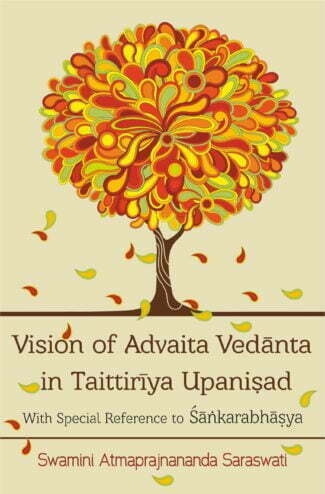
This book unveils the vision of Advaita Vedanta in Taittiriya Upanishad with special reference to Shankarabhashya in a unique style, detailing the importance of shabda-pramana, along with free translations of three vallis of the Upanishad. It presents the oneness of triangular phenomenon called jiva, jagat and Ishvara from the Advaita Vedanta perspective.
This book unveils the vision of Advaita Vedanta in Taittiriya Upanishad with special reference to Shankarabhashya in a unique style. Upanishads are shabda-pramana, and this work adequately details the six pramanas, which hold the key to understand the significance of shabda-pramana, along with the five shanti-mantras in Taittiriya Upanishad. As the crux, it analyses Shankaras commentary Taittiriya-Bhashyam on Taittiriya Upanishad, enabling one to understand the deep layers of Advaita Vedanta in detail.
The core theme Vision of Advaita in Taittiriya Upanishad discusses the oneness of the triangular phenomenon called jiva, jagat and Ishvara. It delves deep into the method of deciphering the mahavakyas as well. While following closely the source literature, this volume attempts to detail the nuances of Taittiriya-Bhashyam. The approach of navigating the reader to the principal theme of Advaita Vedanta is expected to give him/her a good background. In ensuring this the volume provides relevant citations and informative explanatory notes. More importantly, it across three vallis Shikshavalli, Brahmanandavalli and Bhriguvalli provides free translations of Taittiriya Upanishad.
This elaborate and scholarly book is expected to add great value to students who wish to have a better understanding of the great Indian tradition called Advaita Vedanta.
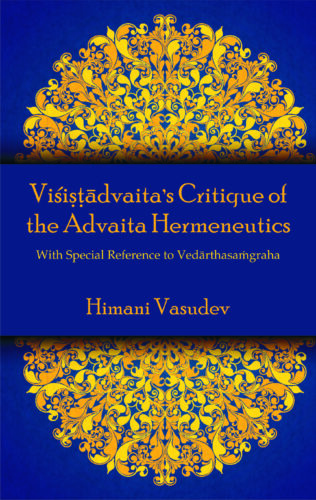
Vedānta is the very heart of Indian philosophy. The various schools of Vedānta have been explored under diverse categories including ontological and epistemological, but they are a storehouse of so much more. “Hermeneutics” in simple words can be the theory of interpretation and this book has studied the critique of the Advaita hermeneutics by Rāmānujācārya based on Vedic statements like tat tvam asi, tadaikāta bahu syāma, neha nānāsti kiñcana and many others in his book Vedārthasaṁgraha which mirrors a complete vision of the Upaniṣads. Rāmānujācārya has shown how the Śruti statements can be seen in a coherent manner resolving the conflicts of bheda and abheda. The nature of a word and its various śaktis, followed by how successful are words in describing the concepts of sat, cit and ānanda, are also discussed here.
This book is an initial effort in the hermeneutic studies of Indian texts, which have been kept limited to the scope of philosophy, theology or religion alone. Many more linguistic treasures can be found here.
Vedānta is the very heart of Indian philosophy. The various schools of Vedānta have been explored under diverse categories including ontological and epistemological, but they are a storehouse of so much more. “Hermeneutics” in simple words can be the theory of interpretation and this book has studied the critique of the Advaita hermeneutics by Rāmānujācārya based on Vedic statements like tat tvam asi, tadaikāta bahu syāma, neha nānāsti kiñcana and many others in his book Vedārthasaṁgraha which mirrors a complete vision of the Upaniṣads. Rāmānujācārya has shown how the Śruti statements can be seen in a coherent manner resolving the conflicts of bheda and abheda. The nature of a word and its various śaktis, followed by how successful are words in describing the concepts of sat, cit and ānanda, are also discussed here.
This book is an initial effort in the hermeneutic studies of Indian texts, which have been kept limited to the scope of philosophy, theology or religion alone. Many more linguistic treasures can be found here.
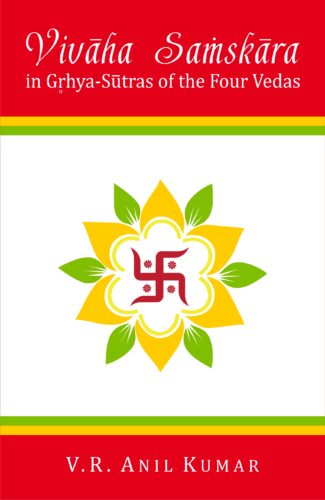
Of a rare kind, this book does comparative analyses after studying seventeen Grhya-Sutras across four Vedas of the number and type of rituals of marriage in each Grhya-Sutra and the order of performance of rituals. It also lists the mantras (with English translation) and their sources and talks about the differences in employing the mantras.
Vivaha (marriage), in Hindu society, is one of the most important samskaras, out of the sixteen sacraments, which a person steps in with full understanding/consciousness. Marriage is a fascinating experience that stays alive in ones mind throughout the life. The mantras and slokas of the Grhya-Sutras of the four Vedas, chanted in this ritual, are in Sanskrit and a vast majority is unaware of their meanings and just follows the instructions of the celebrant priest, purohita.
The author delves deep into the Grhya-Sutras of Vedas and brings forth the details of vivaha samskara principles, philosophy, practices, rituals and so on. Grhya-Sutras Asvalayana, Sankhayana and Kausitaki of Rigveda; Paraskara (Sukhla Yajurveda), Apastamba and Hiranyakesin (Krsna Yajurveda), Baudhayana, Varaha, Manava, Agnivesya, Bharadvaja, Kathaka and Vaikhanasa of Yajurveda; Gobhila, Khadira and Jaimini of Samaveda; and Kausika of Atharvaveda are well explored and seriously analysed, having given the original mantras in Sanskrit with their English translation.
Of a rare kind, this book does comparative analyses of the number and type of rituals in each Grhya-Sutra and the order of performance of rituals.
This scholarly work creates a sudden seriousness and sanctity to vivaha samskara through the detailing of mantras and the rituals. Being in it, one is not far off the Vedic period, giving a new meaning and dimension to our understanding of Hindu vivaha samskara and its sanctity.
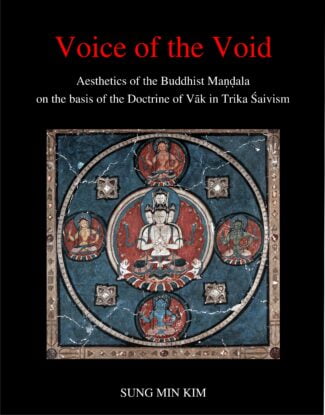
This volume examines how the perceptible form of Buddhist mandalas represents shunya (void), with special reference to the mandalas of Tabo and Alchi. On the basis of the concept of vak (subtle sound) in Trika Shaivism of Kashmir, it investigates where their aesthetic power derives from.
The research undertaken here about Buddhist mandalas is basically designed under the philosophical question how the visible dimensions of forms are related to their invisible contents. The textual sources in reference to Buddhist mandalas teach that the essence of mandalas is shunya (void) and their forms are the reflective images (pratibimba) of shunya. This volume investigates how the colourful form of Buddhist mandalas represents the prime concept of shunya, and what makes these mandalas visually powerful, leaving the impression of ßspiritual enhancementû in the heart of people who do not even know about the Buddhist doctrines.
The mandalas permanently represented in the monastic complexes of Tabo and Alchi in the Western Himalayas have been focused in order to examine a prominent role of visual dimensions of mandalas. In order to comprehend mandalas in the context of Buddhist philosophy, the texts of the Yoga-Tantra class have been looked up. Especially, the references to the tantric visualization-practice throw light on the internal experiences with mandalas.
Considering the fact that the Buddhist mandalas have been developed as a method of Mantrayana, being always combined with mantras and mudras, this volume presents the concept of vak (word, subtle sound, voice) as a key to explain how the ultimate state of shunya and perceptible forms of mandalas are related to each other. The doctrine of vak developed in the tradition of Trika Shaivism in Kashmir provides us with a systematic way to explain the non-dualism between all phenomenal objects and the Supreme Divine. The doctrine of four levels of vak is examined in the book for the purpose of interpreting the aesthetic phenomena and structuring the different levels of meanings of mandalas from the aesthetic perspective. On the basis of the vak theory, the external forms of mandalas have been explored and their visual principles have been technically analysed, in attempt to answer the question: how do the colourful forms of Buddhist mandalas resemble the formless shunya?

This book contains articles that examine the contribution of women saints from India and abroad and discuss the origin of bhakti, the Bhakti Movement, theris, and bhakti/saint poetesses. Their contribution constitutes a rich tradition of devotional discourse in terms of form as well as content.
This volume comprises articles that examine the contribution of women saints from India and abroad as well. The articles discuss the origin of bhakti, the Bhakti Movement, and bhakti/saint poetesses like Rishika Gargi, theris, Andal, Lal Ded, Akka Mahadevi, Mirabai, Gangasati, Tarigonda Vengamamba, Janabai, Bahinabai, Madhabi Dasi, Hildegard of Bingen, and Julian of Norwich from different regions and religions. Their contribution constitutes a rich tradition of devotional discourse in terms of form as well as content and has survived till now in folk and learned traditions. The articles discuss their voices, visions and sufferings physical and psychological and also the way they transcended them and voiced them in their compositions. Their uniqueness lies in their existence at multiple levels social, poetic, religious and spiritual among others. The volume would interest literary, cultural historians and religious scholars as well as general readers.

Interreligious dialogue is one of the important ways for overcoming cultural and religious differences and misunderstandings. But it has to reach the depths of the spiritual, philosophical and theological insights of the religious traditions. This volume throws light on concepts of Void (sunya) and Fullness (purna, in Greek pleroma) in the Buddhist, Hindu and Christian traditions.
Interreligious dialogue is one of the important ways for overcoming cultural and religious differences and misunderstandings, and for contributing to world peace. But such a dialogue has to go beyond the social, institutional and purely academic areas: it has to reach the very depths of the spiritual, philosophical and theological insights of the religious traditions. In Buddhism, Hinduism and Christianity such insights are expressed in the apparently opposite, but in reality complementary concepts of Void (shunya) and Fullness (purna, in Greek pleroma). These concepts lead to the respective spiritual experiences and their interpretations in scriptures and philosophies. This volume contains the papers presented at an interreligious seminar at Sarnath, Varanasi, organised by the Abhishiktananda Society, and inspired by the ideas and life of Swami Abhishiktananda (1910-1973). These papers throw light on these fundamental concepts from the different traditions, and are an invitation to dialogue. H.H. the Dalai Lama gave the concluding speech on the importance of interreligious dialogue.
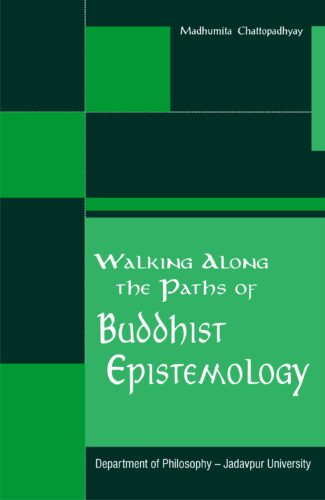
This is a book on Buddhist epistemology dealing with different epistemological topics like the nature of knowledge, validity of knowledge, knowledge of knowledge, perception, erroneous perception, among others. The author has referred to different Sanskrit texts and literature available on these topics.
The monograph highlights the philosophical arguments offered by Buddhist thinkers on different aspects of knowledge. Various aspects of Buddhist epistemology right from the basic question of what the Buddhists mean by knowledge, the varieties of knowledge according to their belief and their explanations of the validity of knowledge are examined. A painstaking work of Prof. Madhumita Chattopadhyay, this study deals with different epistemological topics like the nature of knowledge, validity of knowledge, knowledge of knowledge, perception, erroneous perception, inference and its related issues like ascertainment of vyapti, antarvyapti, prasanganuman and fallacies of inference. The author has referred to many primary sources which include different Sanskrit texts as well as the latest secondary literature available on these topics and discusses the important role of concept of absence and the theory of apoha or negative nominalism as a substitute for universals in Buddhist metaphysics. An attempt is made to explore whether solutions to modern epistemo-logical problems as found in the Western tradition can be provided from the Buddhist perspective in order to show that Buddhist epistemology has a relevant role to play in the area of epistemology itself. The book would interest scholars and students interested in the epistemological and logical aspects of Buddhist philosophy.
| There are no products |